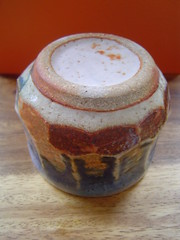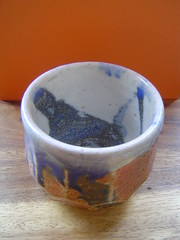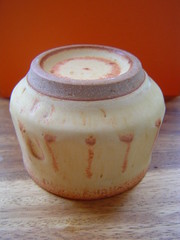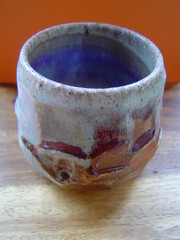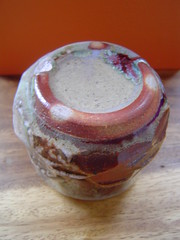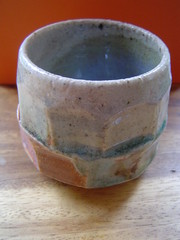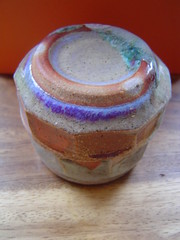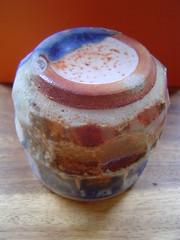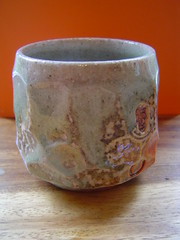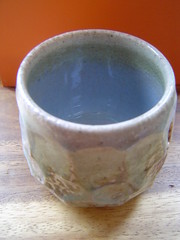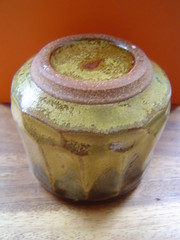No worries, take your time and enjoy the tea!!hooksie wrote:Got a review coming to you soon Chris. Been out of state and hadn't had the chance to give it an indepth spin yet.
May 27th, '09, 10:52
Posts: 258
Joined: Apr 28th, '09, 18:04
Location: Chicago
Contact:
chicagopotter
May 31st, '09, 01:16
Posts: 258
Joined: Apr 28th, '09, 18:04
Location: Chicago
Contact:
chicagopotter
Jun 2nd, '09, 00:34
Posts: 258
Joined: Apr 28th, '09, 18:04
Location: Chicago
Contact:
chicagopotter
Ok, so still no pics of finished pieces. Hopefully these will suffice till then 
Here are some yunomi in the bisque stage. In a nutshell, clay (typically) goes through two firings. The first being called the bisque which makes raw or green clay (do I sense a theme developing) much stronger yet still very porous. The bisqueware is then glazed (usually) and then fired one more time. This final firing matures the clay body and transforms the raw glaze into a vitreous surface.
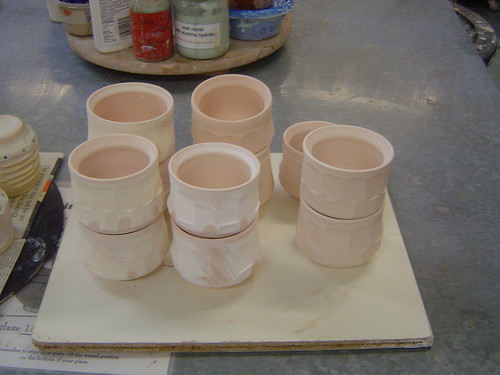
These pieces are waiting to be glazed both inside and out for a cone 10 gas reduction firing:

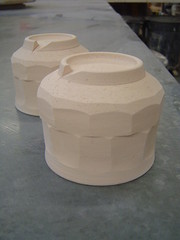
The outside of the following pieces are covered in either Smooth Orange or Mustard Yellow flashing slip. They will get an interior liner glaze and be fired to cone 10 in a soda kiln. When the soda mixture is introduced into the kiln at about 2200 degrees, it volatilizes, moves throughout the chamber along the flame path, and reacts with the pieces therein. Because these yunomi have a high alumina flashing slip on them, the exteriors will not become glazed by the soda. They will, in turn, flash in such a manner that emphasizes the path the flame took around the ware during firing.
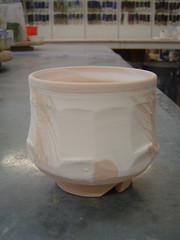


A quick note about the feet on these pieces: I've started to extend them a bit -- this raises them off whatever surface they may be sitting on both physically and visually. This change seemed to be a natural evolutionary step for these pieces...
Here are some yunomi in the bisque stage. In a nutshell, clay (typically) goes through two firings. The first being called the bisque which makes raw or green clay (do I sense a theme developing) much stronger yet still very porous. The bisqueware is then glazed (usually) and then fired one more time. This final firing matures the clay body and transforms the raw glaze into a vitreous surface.

These pieces are waiting to be glazed both inside and out for a cone 10 gas reduction firing:


The outside of the following pieces are covered in either Smooth Orange or Mustard Yellow flashing slip. They will get an interior liner glaze and be fired to cone 10 in a soda kiln. When the soda mixture is introduced into the kiln at about 2200 degrees, it volatilizes, moves throughout the chamber along the flame path, and reacts with the pieces therein. Because these yunomi have a high alumina flashing slip on them, the exteriors will not become glazed by the soda. They will, in turn, flash in such a manner that emphasizes the path the flame took around the ware during firing.



A quick note about the feet on these pieces: I've started to extend them a bit -- this raises them off whatever surface they may be sitting on both physically and visually. This change seemed to be a natural evolutionary step for these pieces...
I like that foot better too. The basic shape and size is nice.

- Victoria -
http://victoriasown.blogspot.com/
http://victoriasown.blogspot.com/
Jun 2nd, '09, 12:38
Posts: 258
Joined: Apr 28th, '09, 18:04
Location: Chicago
Contact:
chicagopotter
Jun 2nd, '09, 14:23
Posts: 109
Joined: May 16th, '09, 20:28
Location: Moss Beach, California
Contact:
Moss
Funny. I am starting to lower my feet now which I think is an evolution. Interesting how we create "similar" things yet have huge differences and evolution paths.
I love ceramics that way. You even use the same slip I do on my crackle yunomi (smooth orange) and get a totally different effect.
Just goes to show that the system is so complex that you could never really copy someone even give the same materials. Your own voice will come through.
Love the pics and the explanation.
I love ceramics that way. You even use the same slip I do on my crackle yunomi (smooth orange) and get a totally different effect.
Just goes to show that the system is so complex that you could never really copy someone even give the same materials. Your own voice will come through.
Love the pics and the explanation.
Matt Brown
Moss Beach Ceramics
www.mossbeachceramics.etsy.com
www.mossbeachceramics.com
Available at Teance tea room, Berkeley, California
Moss Beach Ceramics
www.mossbeachceramics.etsy.com
www.mossbeachceramics.com
Available at Teance tea room, Berkeley, California

